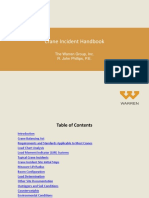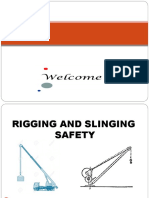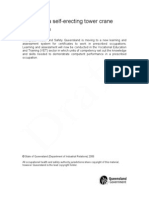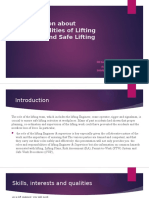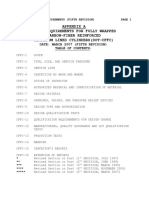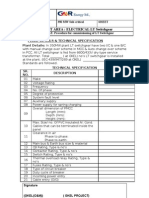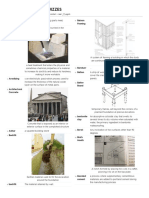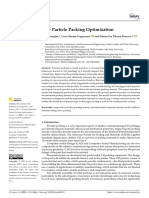100%(1)100% found this document useful (1 vote)
2K viewsOSHA Crane Inspection Guidelines
OSHA Crane Inspection Guidelines
Uploaded by
misu110382The document provides guidelines for inspecting mobile cranes, including:
- Conducting pre-inspections to check operator qualifications and crane certifications.
- Ensuring proper crane setup regarding leveling, outriggers, stability, and structural integrity.
- Checking for electrical hazards such as maintaining clearance from power lines.
- Verifying use of proper load charts.
- Following safe operating precautions such as planning, inspections, and qualified operation.
- Detailing two types of inspections - frequent (daily to monthly) and periodic - and components to check.
Copyright:
Attribution Non-Commercial (BY-NC)
Available Formats
Download as PDF, TXT or read online from Scribd
OSHA Crane Inspection Guidelines
OSHA Crane Inspection Guidelines
Uploaded by
misu110382100%(1)100% found this document useful (1 vote)
2K views11 pagesThe document provides guidelines for inspecting mobile cranes, including:
- Conducting pre-inspections to check operator qualifications and crane certifications.
- Ensuring proper crane setup regarding leveling, outriggers, stability, and structural integrity.
- Checking for electrical hazards such as maintaining clearance from power lines.
- Verifying use of proper load charts.
- Following safe operating precautions such as planning, inspections, and qualified operation.
- Detailing two types of inspections - frequent (daily to monthly) and periodic - and components to check.
Copyright
© Attribution Non-Commercial (BY-NC)
Available Formats
PDF, TXT or read online from Scribd
Share this document
Did you find this document useful?
Is this content inappropriate?
The document provides guidelines for inspecting mobile cranes, including:
- Conducting pre-inspections to check operator qualifications and crane certifications.
- Ensuring proper crane setup regarding leveling, outriggers, stability, and structural integrity.
- Checking for electrical hazards such as maintaining clearance from power lines.
- Verifying use of proper load charts.
- Following safe operating precautions such as planning, inspections, and qualified operation.
- Detailing two types of inspections - frequent (daily to monthly) and periodic - and components to check.
Copyright:
Attribution Non-Commercial (BY-NC)
Available Formats
Download as PDF, TXT or read online from Scribd
Download as pdf or txt
100%(1)100% found this document useful (1 vote)
2K views11 pagesOSHA Crane Inspection Guidelines
OSHA Crane Inspection Guidelines
Uploaded by
misu110382The document provides guidelines for inspecting mobile cranes, including:
- Conducting pre-inspections to check operator qualifications and crane certifications.
- Ensuring proper crane setup regarding leveling, outriggers, stability, and structural integrity.
- Checking for electrical hazards such as maintaining clearance from power lines.
- Verifying use of proper load charts.
- Following safe operating precautions such as planning, inspections, and qualified operation.
- Detailing two types of inspections - frequent (daily to monthly) and periodic - and components to check.
Copyright:
Attribution Non-Commercial (BY-NC)
Available Formats
Download as PDF, TXT or read online from Scribd
Download as pdf or txt
You are on page 1of 11
Mobile Crane Inspection Guidelines for OSHA Compliance Officers: 4.
0 Inspecting A Mobile Crane
U.S. Department of Labor
Occupational Safety & Health Administration
www.osha.gov Search
Advanced Search | A-Z Index
<<< Back to Mobile Crane Inspection Guidelines for the Compliance Officers
Printing Instructions
Mobile Crane Inspection Guidelines
for OSHA Compliance Officers
4.0 Inspecting A Mobile Crane
Since cranes impact such a large segment of work going on at any job site, crane inspections (to the OSHA
Compliance Officer and Project Safety Managers) must include a survey, or walk around, of the entire operation
that questions how the crane will be operating and how other crafts will be effected by working with and around the
crane? Observation of crane operations prior to an inspection, or simply asking how cranes have or will be used, can
indicate possible problem areas that may need a closer review during the inspection process.
4.1 Preinspection
Before the actual inspection, some general information about the crane operator's qualifications and the crane's
certifications should be gathered, such as:
Operator Qualifications Observe the operator in action and when the opportunity permits ask a few question concerning
the cranes capacity and restrictions imposed, either due to activity involved in or functional limitations.
Crane Records Ask for inspection and maintenance records and verify that the appropriate operator's manual and load
charts are available for that particular crane in use.
4.2 Crane Setup
In your initial survey of crane operations, look for crane stability, physical obstructions to movement or operation,
and proximity of electrical power lines, as well as the following:
A. Leveling Has the crane operator set the crane up level and in a position for safe rotation and operation?
B. Outriggers Are the outriggers, where applicable, extended and being used in accordance with
manufacturer's recommendations?
C. Stability The relationship of the load weight, angle of boom, and its radius (the distance from the cranes center of rotation
to the center of load) to the center of gravity of the load. Also, the condition of crane loading where the load moment
acting to overturn the crane is less than the moment of the crane available to resist overturning.
D. Structural Integrity The crane's main frame, crawler, track and outrigger supports, boom sections, and attachments are
all considered part of structural components of lifting. In addition, all wire ropes, including stationary supports,
help determine lifting capacity and are part of the structural elements of crane operations.
4.3 Electrical Hazards
Working around or near electrical power lines is one of the most dangerous practices for crane operations. The
OSHA requirements limit crane operations to a minimum clearance of 10 feet.
Cranes should not be used to handle materials or loads stored under electric power lines. In addition, operation of
mobile cranes near de-energized electric power lines is not recommended until the following steps have been taken:
The power company or owner of the power line has deenergized the lines.
The lines are visibly grounded and appropriately marked at jobsite.
Durable warning signs are installed at the operator's station and on the outside of the crane identifying the
clearance requirements between the crane/load and electrical power lines.
A qualified representative of the power company or owner of the electrical power line are on the job site to verify that
the power lines have been de-energized or properly grounded.
4.4 Load Charts
Load Charts are the principle set of instructions and requirements for boom configurations and parts of line which
http://www.osha.gov/SLTC/cranehoistsafety/mobilecrane/mobilecrane_4.html (1 of 11) [9/10/08 10:40:03 PM]
Mobile Crane Inspection Guidelines for OSHA Compliance Officers: 4.0 Inspecting A Mobile Crane
establish crane capacity for safe crane operations
*
.
Availability The crane operator must have in his/her possession the appropriate load charts related to the crane in use and
for the loads being lifted.
Correct Use The crane operator must show adequate understanding and proficient use of the load charts as related to
the equipment in use and the loads being lifted.
4.5 Safe Operating Precautions
As stated above, cranes are carefully designed, tested, and manufactured for safe operations. When used properly they
can provide safe reliable service to lift or move loads. Because cranes have the ability to lift heavy loads to great heights,
they also have an increased potential for catastrophic accidents if safe. operating practices are not followed.
Accidents can be avoided by careful job planning. The person in charge must have a clear understanding of the work to
be performed and consider all potential dangers at the job site. A safety plan must be developed for the job and must
be explained to all personnel involved in the lift.
Before operations begin for the day, a walkaround inspection needs to be conducted to ensure that the machine is in
proper working condition. Only qualified and properly designated people shall operate the crane. Regular inspections
are important, they provide a means of detecting potential hazards or conditions that could contribute to a sequence of
events leading to an accident. Safe, reliable, and the economic operation of lifting equipment, cannot be ensured
without regular safety inspections and thorough preventive maintenance programs. A thorough inspection program
can forecast maintenance needs or potential equipment failures or malfunctions. The lack of such a program could result
in serious deterioration of the equipment which might lead to excessive replacement, or repair charges, as well as
an increased potential for accidents.
*
See General Load Charts and Operational Considerations, Appendix B.
Due to the wide variation of conditions under which a crane may operate, it is
impossible for the manufacturer to determine inspection intervals appropriate for
every situation. Inspection intervals recommended in manufacturer's publications
represent minimum intervals for average operating conditions. More frequent
inspection intervals should be required if use and site conditions are severe and
warrant it. Inspections are also designed as maintenance checks and/or as a
verification that proper repairs or modifications of equipment have been
completed which, if not checked could affect capacities as well as personnel
safety. Since the initial load rating for cranes was determined and set under ideal
conditions, inspections are required by manufacturers to guarantee optimal
operating efficiency and capacity as determined by the load charts.
Tower Crane Collapse
(Cleaning Up Debris)
The American National Standards Institute, ANSI B30.5, (1968), and OSHA both
require inspections be divided into two categories: frequent and periodic. In
addition to the performance of these regular inspections, equipment is required to
be inspected and tested to ensure that it is capable of safe and reliable operation
when initially set or placed in service and after any major repairs or any design
modification.
http://www.osha.gov/SLTC/cranehoistsafety/mobilecrane/mobilecrane_4.html (2 of 11) [9/10/08 10:40:03 PM]
Mobile Crane Inspection Guidelines for OSHA Compliance Officers: 4.0 Inspecting A Mobile Crane
Crawler Crane
Prepared for Inspection
4.6 Inspection Types
A. Frequent Inspections (daily to monthly intervals). Frequent inspections are usually performed at the start of each shift by
the operator who walks around the crane looking for defects or problem areas. Components that have a direct bearing on
the safety of the crane and whose status can change from day to day with use must be inspected daily, and when
possible, observed during operation for any defects that could affect safe operation. To help determine when the crane is
safe to operate, daily inspections should be made at the start of each shift. Frequent inspections should include, but are
not limited to the following:
1. Check that all exposed moving parts are guarded. A removed guard may indicate that a mechanic is still working on part
of the crane.
2. Visually inspect each component of the crane used in lifting, swinging, or lowering the load or boom for any defects that
might result in unsafe operation.
3. Inspect all wire rope (including standing ropes), sheaves, drums rigging, hardware, and attachments. Remember, any
hook that is deformed or cracked must be removed from service. Hooks with cracks, excessive throat openings of 15%,
or hook twists of 10 degrees or more, must be removed from service.
4. Check for freedom of rotation of all swivels.
5. Visually inspect the boom and jib for straightness and any evidence of physical damage, such as cracking, bending, or
any other deformation of the welds. Look for corrosion under any attachments that are connected to the chords and
lacing. Watch carefully for cracking or flaking of paint. This may indicate fatigue of the metal which often precedes a
failure. On lattice booms, look for bent lacing. If they are kinked or bent, the main chord can lose substantial support in
that area. When lacing is bent, the ends also tend to draw together which pulls the main chords out of shape. This
precaution is especially important on tubular booms where every component must be straight and free from any dents.
Do not attempt to straighten these members by hammering or heating them and drawing them out. They must be cut
out and replaced with lacing to the manufacturer's specifications, procedures, and approval.
6. Inspect tires for cuts, tears, breaks, and proper inflation.
7. Visually inspect the crane for fluid leaks, both air and hydraulic.
8. Visually check that the crane is properly lubricated. The fuel, lubricating oil, coolant and hydraulic oil reservoirs should
be filled to proper levels.
9. Check that the crane is equipped with a fully charged fire extinguisher and that the operator knows how to use it.
10. Check all functional operating mechanisms such as: sheaves, drums, brakes, locking mechanisms, hooks, the boom, jib,
hook rollers brackets, outrigger components, limit switches, safety devices, hydraulic cylinders, instruments, and lights.
11. Check the turntable connections for weld cracks and loose or missing bolts. If they are loose, there is a good chance that
they have been stretched.
12. When checking the outriggers be sure that neither the beams nor the cylinders are distorted. Check that the welds are
not cracked and that both the beams and cylinders extend and retract smoothly and hold the load. Check the condition
of the floats, and check that they are securely attached.
13. Inspect and test all brakes and clutches for proper adjustment and operation.
14. Always inspect boom hoist lockout and other operator aids, such as anti-two-block devices (ATB) and load moment
indicators (LMI), for proper operation and calibration.
15. While the engine is running, check all gauges and warning lights for proper readings and operate all controls to see that
they are functioning properly.
16. Check for any broken or cracked glass that may affect the view of the operator.
B. Periodic Inspections (1 to 12 month intervals). The periodic inspection procedure is intended to determine the need for
repair or replacement of components to keep the machine in proper operating condition. It includes those items listed
http://www.osha.gov/SLTC/cranehoistsafety/mobilecrane/mobilecrane_4.html (3 of 11) [9/10/08 10:40:03 PM]
Mobile Crane Inspection Guidelines for OSHA Compliance Officers: 4.0 Inspecting A Mobile Crane
for daily inspections as well as, but not limited to, structural defects, excessive wear, and hydraulic or air leaks.
Inspection records of the inspected crane shall be maintained monthly on critical items in use, such as brakes, crane
hooks, and ropes. These inspection records should include, the date of inspection, the signature of the person who
performed the inspection, and the serial number, or other identifier. This inspection record should be kept readily available
for review. The manufacturer's maintenance and inspection records, forms/checklist, or equivalent should be used.
1. Inspect the entire crane for structural damage. Be careful to check for distortion or cracks in main frame,
outrigger assemblies, and structural attachments of the upperworks to the carrier.
2. Inspect all welded connections for cracks. Inspect the main chords and lacings and other structural items for paint flaking
and cracking which may indicate potential failure, as well as for dents, bends, abrasions, and corrosion. Check
hydraulic booms for bending, side sway, or droop.
3. Check for deformed, cracked, or corroded members in the load/stress bearing structure. Magnetic particle or other
suitable crack detecting inspection should be performed at least once each year by an inspection agency retained by
the owner. Inspection reports should be requested and retained in the crane file.
4. Inspect cracked or worn sheaves and drums.
5. Inspect for worn, cracked, or distorted parts such as: pins, bearings, shafts, gears, rollers, locking devices, hook
roller brackets, removable outrigger attachments lugs, and welds.
6. Inspect for excessive wear on brake and clutch system parts, linings, pawls, and ratchets.
7. Inspect all indicators, including load and boom angle indicators, for proper operation and calibration.
8. Inspect all power plants for proper operation.
9. Inspect for excessive wear on drive sprockets and/or chain stretch.
10. Inspect for correct action of steering, braking, and locking devices.
11. Check that the counterweight is secure.
12. Check that the identification number is permanently and legibly marked on jibs, blocks, equalizer beams, and all
other accessories.
13. Inspect all hydraulic and pneumatic hoses, fittings, and tubing. Any deterioration of any system component should cause
the inspector to question whether further use would constitute a safety hazard. Conditions, such as the following,
require replacement of the part in question:
a. Any evidence of oil or air leaks on the surfaces of flexible hoses or at the point at which the hose in question joins the
metal end couplings.
b. Any abnormal deformation of the outer covering of hydraulic hose, including any enlargement, local or otherwise.
c. Any leakage at connections which cannot be eliminated by normal tightening.
d. Any evidence of abrasive wear that could have reduced the pressure retaining capabilities of the hose or tube effected.
The cause of the rubbing or abrasion must be immediately eliminated.
4.7 Starting the Inspection
Since most crane inspections begin with a general walkaround and observation of the overall crane set up and
operation, followed by a specific inspection of items or components, the following guidelines are presented in that order.
The first section addresses the general items and operational considerations when inspecting any type of crane, followed
by the specific inspection items for two specific types of cranes; Grove Rough Terrain 45 Ton (hydraulic) and Manitowoc
4100 150 Ton Crawler (lattice boom friction) cranes.
In general, the following should be considered when inspecting any crane:
1. Request for and review all inspection and maintenance documents for the crane being inspected, including the
crane manufacturer's inspection and maintenance requirements.
2. Conduct a walkaround inspection, paying particular attention to mechanical systems leaks or damage (oil, hydraulic, air)
and structural deficiencies.
3. Look at crane cab for properly marked controls, damaged instruments and for properly displayed and legible load charts.
4. Ask the operator, ground crew (riggers), and/or supervisors appropriate questions on load charts, rigging and load
weight determinations, and capacities.
5. Request the operator to raise and lower the boom/load line, where practical, and inspect, from the cab position, the
running line or rope of the main hoist drum and secondary line or jib line. Check brake action and its ability to stop.
6. If practical, request the operator to lower boom to look at the condition of booms sections, lacing, lifting components,
anti-two-block devices, jib back stops, and the condition of the hook.
7. Check crane set up and stability of outriggers on hydraulics and/or the effectiveness of cribbing on crawlers. if
possible, request that the crane be rotated to check all clearances and overall stability.
4.8 Specific Inspection Items and References
The following table identifies the specific inspection items for cranes as well as a brief description and purpose to help
the inspector to have a better understanding of what and why the item is being inspected.
Table 4.8A Inspection Items and Description
ITEM DESCRIPTION / PURPOSE
http://www.osha.gov/SLTC/cranehoistsafety/mobilecrane/mobilecrane_4.html (4 of 11) [9/10/08 10:40:03 PM]
Mobile Crane Inspection Guidelines for OSHA Compliance Officers: 4.0 Inspecting A Mobile Crane
(1) Manufacturer's operating and
Maintenance Manuals
Manufacturer's operating and maintenance
manuals shall accompany all mobile hoisting
equipment. These manuals set forth specific
inspection, operation and maintenance criteria
for each mobile crane and lifting capacity.
(2) Guarding All exposed moving parts such as gears, chains,
reciprocating or rotating parts are guarded or
isolated.
(3) Swing Clearance Protection Materials for guarding rear swing area.
(4) High-Voltage Warning Sign High-voltage warning signs displaying restrictions
and requirements should be installed at the
operator's station and at strategic locations on
the crane.
(5) Boom Stops Shock absorbing or hydraulic type boom stops
are installed in a manner to resist boom
overturning.
(6) Jib Boom Stops Jib stops are restraints to resist overturning.
(7) Boom Angle Indicator A boom angle indicator readable for the operator
station is installed accurately to indicate boom
angle.
(8) Boom Hoist Disconnect, Automatic Boom
Hoist Shutoff
A boom hoist disconnect safety shutoff or
hydraulic relief automatically stops the boom
hoist when the boom reaches a predetermined
high angle.
(9) Two-Blocking Device Cranes with telescoping booms should be
equipped with a two-blocking damage prevention
feature that has been tested on-site in
accordance with manufacturers requirements. All
cranes hydraulic and fixed boom used to hoist
personnel must be equipped with two-blocking
devices on all hoistlines intended to be used in
the operation. The anti-two blocking device has
automatic capabilities for controlling functions
that may cause a two-blocking condition.
(10) Power Controlled Lowering Cranes for use to hoist personnel must be
equipped for power controlled lowering operation
on all hoistlines. Check clutch, chains, and
sprockets for wear.
(11) Leveling Indicating Device A device or procedure for leveling the crane must
be provided.
(12) Sheaves Sheave grooves shall be smooth and free from
surface defects, cracks, or worn places that could
cause rope damage. Flanges must not be broken,
cracked, or chipped. The bottom of the sheave
groove must form a close fitting saddle for the
rope being used. Lower load blocks must be
equipped with close fitting guards. Almost every
wire rope installation has one or more sheaves
ranging from traveling blocks with complicated
reeving patterns to equalizing sheaves where
only minimum rope movement is noticed.
http://www.osha.gov/SLTC/cranehoistsafety/mobilecrane/mobilecrane_4.html (5 of 11) [9/10/08 10:40:03 PM]
Mobile Crane Inspection Guidelines for OSHA Compliance Officers: 4.0 Inspecting A Mobile Crane
(13) Main Hoist and Auxiliary Drums System Drum crushing is a rope condition sometimes
observed which indicates deterioration of the
rope. Spooling is that characteristic of a rope
which affects how it wraps onto and off a drum.
Spoiling is affected by the care and skill with
which the first larger of wraps is applied on the
drum. Manufacturer's criteria during inspection
usually specify:
Minimum number of wraps to remain on
the drum.
Condition of drum grooves
Condition of flanges at the end of drum.
Rope end attachment.
Spooling characteristics of rope.
Rope condition.
(14) Main Boom, Jib Boom, Boom Extension Boom jibs, or extensions, must not be cracked or
corroded. Bolts and rivets must be tight.
Certification that repaired boom members meet
manufacturers original design standard shall be
documented. Non-certified repaired members
shall not be used until recertified.
(15) Load Hooks and Hook Blocks Hooks and blocks must be permanently labeled
with rated capacity. Hooks and blocks are
counterweighted to the weight of the overhaul
line from highest hook position. Hooks must not
have cracks or throat openings more than 15%
of normal or twisted off center more than 10
o
from the longitudinal axis. All hooks used to hoist
personnel must be equipped with effective
positive safety catches especially on hydraulic
cranes.
(16) Hydraulic Hoses Fittings and Tubing Flexible hoses must be sound and show no signs
of leaking at the surface or its junction with the
metal and couplings. Hoses must not show
blistering or abnormal deformation to the outer
covering and no leaks at threaded or clamped
joints that cannot be eliminated by normal
tightening or recommended procedures. There
should be no evidence of excessive abrasion or
scrubbing on the outer surfaces of hoses, rigid
tubing, or hydraulic fittings.
(17) Outriggers Outrigger number, locations, types and type of
control are in accordance with manufacturer's
specifications. Outriggers are designed and
operated to relieve all weight from wheels or
tracks within the boundaries of the outriggers. If
not, the manufacturer's specifications and
operating procedures must be clearly defined.
Outriggers must be visible to the operator or a
signal person during extension or setting.
(18) Load Rating Chart A durable rating chart(s) with legible letters and
figures must be attached to the crane in a
location accessible to the operator while at the
controls. The rating charts shall contain the
following:
A full and complete range of
manufacturer's crane loading ratings at all
stated operating radii.
Optional equipment on the crane such as
outriggers and extra counterweight which
effect ratings.
A work area chart for which capacities are
listed in the load rating chart, i.e. over
side, over rear, over front.
http://www.osha.gov/SLTC/cranehoistsafety/mobilecrane/mobilecrane_4.html (6 of 11) [9/10/08 10:40:03 PM]
Mobile Crane Inspection Guidelines for OSHA Compliance Officers: 4.0 Inspecting A Mobile Crane
Weights of auxiliary equipment, i.e. load
block, jibs, boom extensions.
A clearly distinguishable list of ratings
based on structural, hydraulic or other
factors rather than stability.
A list of no-load work areas.
A description of hoistline reeving
requirements on the chart or in operator's
manual.
(19) Wire Rope Main hoist and auxiliary wire rope inspection
should include examining for
Broken wires.
Excess wear.
External damage from crushing, kinking,
cutting or corrosion.
(20) Cab Contains all crane function controls in addition to
mechanical boom angle indicators, electric
wipers, dash lights, warning lights and buzzers,
fire extinguishers, seat belts, horn, and clear
unbroken glass.
(21) Braking Systems Truck cranes and self-propelled cranes mounted
on rubber-tired chassis or frames must be
equipped with a service brake system, secondary
stopping emergency brake system and a parking
brake system. Unless the owner/operator can
show written evidence that such systems were
not required by the standards or regulations in
force at the date of manufacture and are not
available from the manufacturer. The braking
systems must have been inspected and tested
and found to be in conformance with applicable
requirements.
Crawler cranes are provided with brakes or other
locking devices that effectively hold the machine
stationary on level grade during the working
cycle. The braking system must be capable of
stopping and holding the machine on the
maximum grade recommended for travel. The
brakes or locks are arranged to engage or remain
engaged in the event of loss of operating
pressure or power.
(22) Turntable/Crane Body Make sure that the rotation point of a crane
gears and rollers are free of damage, wear and
properly adjusted and the components are
securely locked and free of cracks or damage.
The swing locking mechanism must be functional
(pawl, pin) and operated in the cab.
(23) Counterweight The counterweight must be approved and
installed according to manufacturer's
specifications with attachment points secured.
Table 4.8B shows the items that need to be examined for the Grove Rough Terrain 45 Ton Hydraulic Crane and
their corresponding applicable OSHA 29 CFR 1926 and ANSI B30.5 Standards.
Table 4.8B
Rough Terrain 45 Ton Hydraulic Crane
STANDARD
(29 CFR 1926.550)
INSPECTION ITEMS ANSI
B 30.5
http://www.osha.gov/SLTC/cranehoistsafety/mobilecrane/mobilecrane_4.html (7 of 11) [9/10/08 10:40:03 PM]
Mobile Crane Inspection Guidelines for OSHA Compliance Officers: 4.0 Inspecting A Mobile Crane
Outriggers
1. Lubrication
2. Structural Condition
3. Pressure Hoses/Connections
5-1.9.9
5-2.1.3
5-2.1.2
Turntable/Crane Body
1. Ensure Level/Stability
2. Wear/Gear/Teeth/Rollers
3. Cracks
4. Bolts/Ensure Securely Attached
5-1.1 & 5-1.2
Counter Weight
1. Proper Size
2. Attachment Connection/Bolts
5-3.4.2
1926.550(a)(8)
1926.550(a)(13)(ii) & (iii)
----------
1926.550(a)(4)
----------
----------
Engine Housing
1. Cleanliness/No Rags/Trash
2. Gear/Machinery Guards
3. Clear Access/Walkways
4. Brakes/Clutch Adjustments
5. Hand Signal Illustration
6. Swing Break
5-1.9.6
5-1.8.2 & 3
----------
5-2 (Fig.16)
5-1.4
1926.550(a)(12)
----------
----------
1926.550(a)(14)(i)
1926.550(a)(2)
1926.550(a)(13) &
1926.550(a)(13)(iii)
Cab
1. Glass/Visibility
2. Instruments and Controls
3. Functioning Horn (Warning signal)
4. Fire Extinguisher
5. Appropriate Load Charts and Warning
Signs
6. Proper and Adequate Access (Steps/
Walkway)
----------
5-5.1.6.1.1
----------
5-3.4.9
5-5.1.1.3
5-1.8.2 & 3
Drum
1. Proper Size and Spoiling of Hoistlines
2. Drum Sides/Shields for cracks
3. Dogs/Pawls/Locking Devices
4. Drum Rotation vs. Control Motion
5-1.3.1 & 2
http://www.osha.gov/SLTC/cranehoistsafety/mobilecrane/mobilecrane_4.html (8 of 11) [9/10/08 10:40:03 PM]
Mobile Crane Inspection Guidelines for OSHA Compliance Officers: 4.0 Inspecting A Mobile Crane
----------
----------
----------
----------
----------
----------
----------
1926.550(b)
Boom Sections
(Boom sections correspond with crane
model)
1.
2.
3. Boom Stops
4.
5. Hoist Line Guides/Sheaves
6.
7.
8. Jib Attachment/
Backstops/Belly Slings
5-2.1.3
Sheave System
1. Ensure Hoist Line and Sheave Size
Match
2. Worn
3. Lubrication/Move Freely
5-1.7.4
Load/Auxiliary Hook and Block System
1. Sheaves Function Smoothly
2. Hook Rotates Freely/Lubricated
3. Proper Becket
4. Properly Reeved
5-1-7.1-6
1926.550(a)(7)
1926.550(a)(7)(v)
-----------
-----------
Wire Rope/Hoist Line
1. Overall Condition
2. End Connections
3. Lubrication
4. Clips
5-1.7.6
----------
----------
----------
----------
1926.550(a)(9)
1926.550(a)(15)
Safety Devices
1. Anti-Two Block Devices
2. Boom Backstop Devices
3. Swing Radius Warning Devices
4. Job or Site Specific Devices/system
(near electric power/personnel
hoisting platforms)
5-1.1.9
5-2 (Fig. 17)
Additional References:
1926.550(a)(1) ---- Crane used in accordance with manufactures specification.
1926.550(a)(5) ---- Inspection: Competent Person.
1926.550(a)(6) ---- Annual Inspection Record.
1926.550(a)(16) ---- No modifications without written approval of manufacturer.
Table 4.8C shows the items that need to be examined for the Manitowoc 4100 150 Ton Lattice Boom Crawler Crane and their corresponding applicable
OSHA 1926 and ANSI B30.5 Standards.
Table 4.8C 150 Ton Lattice Boom Crawler Crane
STANDARD
(29 CFR 1926.550)
INSPECTION ITEMS ANSI
B 30.5
Track Crawler System
1. Lubrication
2. Connection Bolts
3. Drive Chain (slack & wear)
5-1.9.9
5-2.1.3
5-2.1.2
http://www.osha.gov/SLTC/cranehoistsafety/mobilecrane/mobilecrane_4.html (9 of 11) [9/10/08 10:40:03 PM]
Mobile Crane Inspection Guidelines for OSHA Compliance Officers: 4.0 Inspecting A Mobile Crane
Turntable/Crane Body (Upper Works)
1. Assure Level/Stability
2. Wear/Gear/Teeth/Rollers
3. Cracks
4. Bolts/Pins - Assure Securely Attached
5-1.1 & 5-1.2
Counter Weight
1. Proper Size
2. Attachment Connection/Bolts
5-3.4.2
1926.550(a)(8)
1926.550(a)(13)(ii) & (iii)
---------
1926.550(a)(4)
----------
----------
Engine Housing
1. Cleanliness/No Rags/Trash
2. Gear/Machinery Guards
3. Clear Access/Walkways
4. Brakes/Clutch Adjustments
5. Hand Signal Illustration
6. Swing Break
5-1.9.6
5-1.8.2 & 3
----------
5-2 (Fig.16)
5-1.4
1926.550(a)(12)
-----------
----------
1926.550(a)(14)(i)
1926.550(a)(2)
1926.550(a)(13) &
1926.550(a)(13)(iii)
Cab
1. Glass/Visibility
2. Instruments and Controls
3. Functioning Horn (warning signal)
4. Fire Extinguisher
5. Appropriate Load Charts and Warning
Signs
6. Proper and Adequate Access (steps/
walkway)
----------
5-5.1.6.1.1
----------
5-3.4.9
5-5.1.1.3
5-1.8.2 & 3
Hoist Drum System
1. Proper Size and Spoiling of Hoistlines
2. Drum Sides/Shields for Cracks
3. Dogs/Pawls/Locking Devices
4. Drum Rotation vs. Control Motion
5. Clutch and Brakes
5-1.3.1 & 2
----------
----------
----------
----------
----------
----------
----------
1926.550(b)
Boom Sections
(Boom sections correspond with crane
model)
1. Base Section Properly Attached
2. Pin Clearance
3. Boom Lacing/Cord Damage
4. Boom Stops
5. Gantry System A-Frame
6. Hoist Line Guides/Sheaves
7. Boom Section Connection Pins/Keys
8. Boom and Gantry Support System
9. Jib Attachment/Backstops/Belly Slings
(Jib Security Device)
5-2.1.3
http://www.osha.gov/SLTC/cranehoistsafety/mobilecrane/mobilecrane_4.html (10 of 11) [9/10/08 10:40:03 PM]
Mobile Crane Inspection Guidelines for OSHA Compliance Officers: 4.0 Inspecting A Mobile Crane
Sheave System
1. Ensure Hoistline and Sheave Size
Match
2. Worn
3. Lubrication/Move freely
5-1.7.4
Load/Auxiliary Hook and Block System
1. Sheaves Function Smoothly
2. Hook Rotates Freely/Lubricated
3. Proper Becket
4. Properly Reeved
5-1-7.1-6
1926.550(a)(7)
1926.550(a)(7)(v)
-----------
-----------
Wire Rope/Hoist Line
1. Overall Condition
2. End Connections
3. Lubrication
4. Clips
5-1.7.6
----------
----------
----------
----------
1926.550(a)(9)
1926.550(a)(15)
Safety Devices
1. Anti-Two Block Devices
2. Boom Backstop Devices
3. Swing Radius Warning Devices
4. Job or Site Specific Devices/System/
Program for work near electric power
and use of personnel hoisting
platforms)
5-1.1.9
5-2 (Fig. 17)
Additional references:
1926.550(a)(1) ---- Crane used in accordance with manufactures specification.
1926.550(a)(5) ---- Inspection: Competent Person.
1926.550(a)(6) ---- Annual Inspection Record.
1926.550(a)(16) ---- No modifications without written approval from manufacturers.
Back to Top www.osha.gov
www.dol.gov
Contact Us | Freedom of Information Act | Customer Survey
Privacy and Security Statement | Disclaimers
Occupational Safety & Health Administration
200 Constitution Avenue, NW
Washington, DC 20210
http://www.osha.gov/SLTC/cranehoistsafety/mobilecrane/mobilecrane_4.html (11 of 11) [9/10/08 10:40:03 PM]
You might also like
- Crane and Rigging (Dec 2012)Document84 pagesCrane and Rigging (Dec 2012)Th Nattapong67% (6)
- Ansi - b56-6-2011-r020911 PDFDocument44 pagesAnsi - b56-6-2011-r020911 PDFNatalia Elizabeth Ramos67% (3)
- Basic Rigging Print Materials2Document51 pagesBasic Rigging Print Materials2Img Syg100% (6)
- Crane InspectorDocument5 pagesCrane Inspectordandiar1100% (2)
- Web-Sling-Recommended-Operating-and-Inspection-GuidelineDocument12 pagesWeb-Sling-Recommended-Operating-and-Inspection-Guidelineibrahim100% (1)
- IMS Crane Inspection Guide 1Document43 pagesIMS Crane Inspection Guide 1moahamed ahmed100% (2)
- Asme B30.16, BS 3243, BS 4898Document2 pagesAsme B30.16, BS 3243, BS 4898engmuhmudNo ratings yet
- Lift PlanDocument44 pagesLift PlanKasolo Hassan100% (3)
- Engineering Inspections Guide PUWER Inspections LOLER COSHH and MoreDocument58 pagesEngineering Inspections Guide PUWER Inspections LOLER COSHH and MorecoxshulerNo ratings yet
- Mobile Crane Inspection: © 2001 CIA, Inc 1Document140 pagesMobile Crane Inspection: © 2001 CIA, Inc 1AmeerUlHaq67% (3)
- Mobile CraneDocument84 pagesMobile CraneFar Away100% (1)
- Crane Rigger HandbookDocument140 pagesCrane Rigger Handbookmfxl2994% (34)
- General Crane SafetyDocument4 pagesGeneral Crane SafetyEhab Mostafa AliNo ratings yet
- Derrick-Mast Inspection ProcedureDocument3 pagesDerrick-Mast Inspection ProcedureChandrasekhar Sonar100% (6)
- Ashrae Chart PDFDocument2 pagesAshrae Chart PDFNapoleon Low100% (2)
- COS101-101S-parts Horno Blodgett (Torero) PDFDocument10 pagesCOS101-101S-parts Horno Blodgett (Torero) PDFJose MarcanoNo ratings yet
- CranesDocument80 pagesCranesjoenediath9345No ratings yet
- Mobile Crane Inspection FormDocument6 pagesMobile Crane Inspection FormSham AranNo ratings yet
- Regulationonliftingequipmentprotocol 1 Steditionapril 2010 CsDocument14 pagesRegulationonliftingequipmentprotocol 1 Steditionapril 2010 Csnaseema1No ratings yet
- Regulation IO-11.0 EHS Lifting Equipment Protocol Rev. 00 Jan18Document18 pagesRegulation IO-11.0 EHS Lifting Equipment Protocol Rev. 00 Jan18Revankar B R ShetNo ratings yet
- Cranes and DerricksDocument15 pagesCranes and DerricksAl Hamra AyashofiyaNo ratings yet
- Guide To Inspecting and Maintaining CranesDocument7 pagesGuide To Inspecting and Maintaining CranesBerk TekinNo ratings yet
- Mobile Crane Logbook Permanent Record: (OHS) ActDocument20 pagesMobile Crane Logbook Permanent Record: (OHS) ActAltayeb YassinNo ratings yet
- Mobile Crane Inspection GuidelinesDocument11 pagesMobile Crane Inspection GuidelinesMohammed Atef0% (2)
- Slinging and Signals: Know How To Do It Right! Then Do It Right!Document134 pagesSlinging and Signals: Know How To Do It Right! Then Do It Right!saqibNo ratings yet
- Overhead Crane Operator HandbookDocument42 pagesOverhead Crane Operator HandbookWayneNo ratings yet
- Overhead Crane Operations and Safety - 1 DayDocument4 pagesOverhead Crane Operations and Safety - 1 DaySyarizal ZainuddinNo ratings yet
- Maintenance and Thorough Examination of Mobile CranesDocument106 pagesMaintenance and Thorough Examination of Mobile CranesKate Poole100% (2)
- Rigger Level 1 & 2 RCH0712Document38 pagesRigger Level 1 & 2 RCH0712werdna67No ratings yet
- OSHA Mobile Crane Inspection GuidelinesDocument34 pagesOSHA Mobile Crane Inspection GuidelinesAhmed Imtiaz RaoNo ratings yet
- Crane Incident Handbook: The Warren Group, Inc. R. John Phillips, P.EDocument55 pagesCrane Incident Handbook: The Warren Group, Inc. R. John Phillips, P.Ebugse100% (2)
- Guidance Notes Inspection and Examination - Lifting EquipmentDocument48 pagesGuidance Notes Inspection and Examination - Lifting Equipmentbiopro1100% (1)
- 2d - Guidance On Safe Use of Telehandlers PDFDocument103 pages2d - Guidance On Safe Use of Telehandlers PDFmohammudp100% (1)
- CraneDocument44 pagesCraneEka Kuroba100% (1)
- Cranes, Derricks, Hoists, Elevators, and ConveyorsDocument19 pagesCranes, Derricks, Hoists, Elevators, and ConveyorsAmeerUlHaqNo ratings yet
- Tips For Heavy Lifting AND Rigging Engineering: Inspection: 1Document25 pagesTips For Heavy Lifting AND Rigging Engineering: Inspection: 1pablodugalNo ratings yet
- RIGGING SAFETY TrainingDocument43 pagesRIGGING SAFETY TrainingBG REDDYNo ratings yet
- Articulating Crane Refrence ManualDocument74 pagesArticulating Crane Refrence ManualMarTi MarTinez Davila100% (1)
- Lifting Equipment Controller NotesDocument5 pagesLifting Equipment Controller NotesHitesh GuptaNo ratings yet
- Rigger Reference Manual 0716 PDFDocument110 pagesRigger Reference Manual 0716 PDFSivaram Siva67% (3)
- Standards & CodesDocument15 pagesStandards & Codeseetua86% (7)
- Rigger III PDFDocument1 pageRigger III PDFMohamed Hameem DeenNo ratings yet
- Loler Matrix 2017 PDFDocument1 pageLoler Matrix 2017 PDFMulatua SiraitNo ratings yet
- Cranes & LiftingDocument73 pagesCranes & LiftingEmily Nguyen100% (2)
- Instructions For The Safe Use Of: Wire Rope SlingsDocument2 pagesInstructions For The Safe Use Of: Wire Rope SlingsStuartWilliamGlennieNo ratings yet
- Crane Safety WorkbookDocument34 pagesCrane Safety WorkbookozdoguNo ratings yet
- Crane Hoist Safety ProgramDocument11 pagesCrane Hoist Safety ProgramAssawin AnonuNo ratings yet
- Self Erecting Tower CraneDocument16 pagesSelf Erecting Tower CraneVinoth MalaikaniNo ratings yet
- Crane Operators Trg.Document64 pagesCrane Operators Trg.Bhavya ShuklaNo ratings yet
- 64-Crane Operator Program NcmscurrentDocument5 pages64-Crane Operator Program NcmscurrentJojo Betanio AkajoknoNo ratings yet
- Model 6 - OSHADocument19 pagesModel 6 - OSHAManoj JaiswalNo ratings yet
- Crane Tata SteelDocument39 pagesCrane Tata Steelbabu maheshNo ratings yet
- LOUDEN-Series-600-and-700-Monorail-Track ENGDocument20 pagesLOUDEN-Series-600-and-700-Monorail-Track ENGRicardo Pérez SánchezNo ratings yet
- Crane Lift ManualDocument18 pagesCrane Lift ManualGabriel BorgNo ratings yet
- Sample Crane and Hoist Safety ProgramDocument9 pagesSample Crane and Hoist Safety ProgramChristian AdkinsNo ratings yet
- API Recommended Practice 4G - Exceprt Section 6Document4 pagesAPI Recommended Practice 4G - Exceprt Section 6ANTONI RamNo ratings yet
- Guide To Inspecting and Maintaining CranesDocument8 pagesGuide To Inspecting and Maintaining CranesMohammed MujahidNo ratings yet
- Regulation IO-11.0 Lifting Equipment Protocol Rev. 00, Sep16Document11 pagesRegulation IO-11.0 Lifting Equipment Protocol Rev. 00, Sep16qcnareshkumarariesNo ratings yet
- Presentation About LiftingDocument22 pagesPresentation About LiftingSyed M. Imran Ali100% (1)
- Cps Crane MaintenanceDocument13 pagesCps Crane MaintenanceTarek HareedyNo ratings yet
- Appointed PersonsDocument4 pagesAppointed PersonsPaulNo ratings yet
- HAGS UniPlay 205 PDFDocument116 pagesHAGS UniPlay 205 PDFKostas PapadopoulosNo ratings yet
- Practical Piping Course PDFDocument46 pagesPractical Piping Course PDFBhupendra S KhadtaleNo ratings yet
- Self Healing ConcreteDocument4 pagesSelf Healing ConcreteAvilayyina ANo ratings yet
- Steam Room Construction & Generator Sizing GuideDocument2 pagesSteam Room Construction & Generator Sizing GuideasdthuNo ratings yet
- Denim Première Vision - Denim Fabric Memo AW1718Document99 pagesDenim Première Vision - Denim Fabric Memo AW1718makiyama37No ratings yet
- Data Sheet - 147 Litre Container AssemblyDocument2 pagesData Sheet - 147 Litre Container AssemblyTry deliawatiNo ratings yet
- Ficha Tipo F InglesDocument4 pagesFicha Tipo F InglesTelmo EstrelaNo ratings yet
- Fuel CellDocument27 pagesFuel CellGallium TNo ratings yet
- Impact of A Water JetDocument11 pagesImpact of A Water JetDek RasalaNo ratings yet
- Grass-Based Paper Cup Out of Napier GrassDocument86 pagesGrass-Based Paper Cup Out of Napier GrassMariel Hope VelascoNo ratings yet
- New Features of 660 MW UnitsDocument98 pagesNew Features of 660 MW Unitsrohit_me083100% (2)
- Lab Report PDFDocument2 pagesLab Report PDFAl-Vi John CorpuzNo ratings yet
- CFFC STD CompletoDocument31 pagesCFFC STD CompletolcandoNo ratings yet
- Banana Stem Fiber in Making Eco BagDocument6 pagesBanana Stem Fiber in Making Eco BagMax UmingaNo ratings yet
- Mutual Fund DataDocument47 pagesMutual Fund Datahitesh nandawaniNo ratings yet
- المحاضرة الاولى PDFDocument13 pagesالمحاضرة الاولى PDFمصطہفي أبورويہصNo ratings yet
- Pig - Sig Ni PDFDocument4 pagesPig - Sig Ni PDFgvramakrishnaNo ratings yet
- Concrete Mix DesignDocument3 pagesConcrete Mix DesignSheik Mohamed LiakathNo ratings yet
- LV Switchgear FinalDocument13 pagesLV Switchgear Finalvikivarma147100% (1)
- Defense Scrap Yard HandbookDocument251 pagesDefense Scrap Yard HandbookAFLAC ............0% (1)
- Upd DSLDocument34 pagesUpd DSLViplove SinghNo ratings yet
- Lean Manufacturing Implementation PDFDocument28 pagesLean Manufacturing Implementation PDFFiroj KhanNo ratings yet
- Determination of Calorific Value of Biogas by Using JunkerDocument3 pagesDetermination of Calorific Value of Biogas by Using JunkerSiva Prasad PasupuletiNo ratings yet
- Bonding in Orthodontics .Document72 pagesBonding in Orthodontics .drashishpandey2011No ratings yet
- quizletBT ADocument13 pagesquizletBT ADarren VergaraNo ratings yet
- Final Report AdhesiveDocument109 pagesFinal Report AdhesiveMot EmbyNo ratings yet
- A Ternary Model For Particle Packing OptimizationDocument13 pagesA Ternary Model For Particle Packing OptimizationStefano MartelliNo ratings yet






























